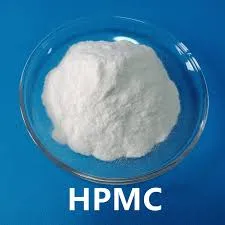
Dec . 04, 2024 17:01 Back to list
what is hpmc
Understanding HPMC An Overview
Hydroxypropyl Methylcellulose (HPMC) is a cellulose derivative that has gained significant attention in various industries due to its unique properties and versatile applications. It is a white or off-white powder that is odorless and tasteless. HPMC is primarily used as a thickener, binder, emulsifier, and film-forming agent in pharmaceutical, food, and construction applications.
Chemical Structure and Properties
HPMC is derived from cellulose, which is a natural polymer found in the cell walls of plants. The modification process involves the introduction of hydroxypropyl and methoxy groups into the cellulose molecule, which enhances its solubility in water. The degree of substitution (DS) of these groups affects the physical properties of HPMC, such as viscosity, gel formation, and solubility at different temperatures.
One of the key characteristics of HPMC is its ability to form gels when combined with water, which is useful in creating controlled-release drug formulations. Its viscosity can be manipulated by altering the concentration, which allows formulators to achieve specific characteristics required for various applications.
Applications in Pharmaceuticals
In the pharmaceutical industry, HPMC is widely used as an excipient in tablet formulations. It acts as a binder to hold the ingredients together, ensuring the integrity of the tablet. Moreover, HPMC is instrumental in controlling the release of active pharmaceutical ingredients (APIs) in the body. This property makes it an ideal candidate for sustained-release and controlled-release formulations, significantly improving drug bioavailability.
HPMC is also utilized in the preparation of capsules and as a coating material for tablets. The film-forming ability of HPMC allows for the creation of enteric coatings, which protect sensitive ingredients from the acidic environment of the stomach, ensuring they are released in the intestine instead.
HPMC in Food Industry
what is hpmc

In the food sector, HPMC is employed as a food additive. It is commonly used as a thickener in sauces, dressings, and soups, helping improve texture and stability. Additionally, it is used as a fat replacer in low-fat and reduced-calorie products, providing a creamy mouthfeel without added calories.
HPMC is recognized as a safe food additive and has been approved for use by various regulatory agencies, including the Food and Drug Administration (FDA) and the European Food Safety Authority (EFSA). Its versatility allows manufacturers to create products that meet the demands of health-conscious consumers while maintaining desirable sensory attributes.
Construction and Building Materials
The construction industry also benefits from HPMC. It is used in mortar, tile adhesives, and other building materials to enhance workability and improve adhesion properties. HPMC improves the water retention of mortars, allowing for longer working times and better performance during the curing process.
In addition, HPMC's gel-forming properties contribute to preventing the segregation of solid particles during the mixing process, resulting in a more uniform and stable product. As the construction industry moves towards sustainable practices, the use of non-toxic and biodegradable additives like HPMC is becoming increasingly popular.
Conclusion
Hydroxypropyl Methylcellulose is a multifunctional polymer that plays a crucial role across various industries, including pharmaceuticals, food, and construction. Its unique properties allow it to serve as a versatile ingredient that enhances the performance of products in a wide range of applications. As research progresses and innovative formulations are developed, the demand for HPMC is likely to grow, paving the way for new applications and advancements in both existing and emerging markets.
In summary, HPMC stands out as a valuable substance that not only contributes to product efficiency and stability but also aligns with the increasing trend towards safer, more sustainable ingredients across multiple sectors. Understanding its properties and applications can help in harnessing its full potential for innovative solutions in future developments.
-
Versatile Hpmc Uses in Different Industries
NewsJun.19,2025
-
Redispersible Powder's Role in Enhancing Durability of Construction Products
NewsJun.19,2025
-
Hydroxyethyl Cellulose Applications Driving Green Industrial Processes
NewsJun.19,2025
-
Exploring Different Redispersible Polymer Powder
NewsJun.19,2025
-
Choosing the Right Mortar Bonding Agent
NewsJun.19,2025
-
Applications and Significance of China Hpmc in Modern Industries
NewsJun.19,2025







